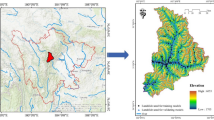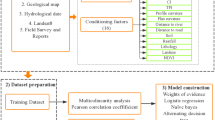Abstract
In this study, a novel method that integrates C4.5 decision tree, weights-of-evidence and m-branch smoothing techniques was proposed for mineral prospectivity mapping. First, a weights-of-evidence model was used to rank the importance of each evidential map and determine the optimal buffer distance. Second, a classification technique that uses a C4.5 decision tree in data mining was used to construct a decision tree classifier for the grid dataset. Finally, an m-branch smoothing technique was used as a predictor, which transformed the decision tree into a probability evaluation tree. The method makes no conditional independence assumption and can be applied for class imbalanced datasets like those collected during mineral exploration for prospectivity mapping of an area. The traits of comprehensibility, accuracy and efficiency were derived from the C4.5 decision tree. In addition, a case study for iron prospectivity mapping was performed in the eastern Kunlun Mountains, China. Sixty-two Skarn iron deposits and eight evidential maps related to iron mineralization were studied. On the final map, areas of low, moderate and high potential for iron deposit occurrence covered areas of 71,491, 14,298, and 9,532 km2, respectively. For the goodness-of-fit test, 91.94 % of the total 62 iron deposits were within a high-potential area, 8.06 % were within a moderate-potential area and 0 % were within a low-potential area. For ten-fold cross-validation, 82.26 % were within a high-potential area, 14.52 % were within a moderate-potential area and 3.22 % were within a low-potential area. To evaluate the predictive accuracy, Receiver Operating Characteristic (ROC) curves and Area Under ROC Curve (AUC) were employed. The accuracy of the goodness-of-fit test reached 97.07 %, and the accuracy of the ten-fold cross-validation was 95.10 %. The majority of the iron deposits were within high-potential and moderate-potential areas, which covered a small proportion of the study area.










Similar content being viewed by others
References
Abedi M, Norouzi GH, Bahroudi A (2012) Support vector machine for multi-classification of mineral prospectivity areas. Comput Geosci 46(1):272–283
Agterberg FP (1992) Combining indicator patterns in weights of evidence modeling for resource evaluation. Nat Resour Res 1(1):39–50
Agterberg FP, Bonham-Carter GF, Cheng QM, Wright DF (1993) Weights of evidence model and weighted logistic regression in mineral potential mapping. In: Davis JC et al (eds) Computers in geology. Oxford University Press, New York, pp 13–32
Aminzadeh F (1994) Applications of fuzzy expert systems in integrated oil exploration. Comput Electr Eng 20(2):89–97
Bonham-Carter GF, Agterberg FP, Wright DF (1989) Weights of evidence modeling: a new approach to mapping mineral potential. Stat Appl Earth Sci 89(9):171–183
Carranza EJM, Hale M (2001) Logistic regression for geologically constrained mapping of gold potential, Baguio District, Philippines. Explor Min Geol 10(3):165–175
Carranza EJM (2004) Weights of evidence modeling of mineral potential: a case study using small number of prospects, Abra, Philippines. Nat Resour Res 13(3):173–187
Cui Y, He BB, Chen JH, He, ZH, Liu Y (2010) Mining metallogenic association rules combining cloud model with apriori algorithm. Proceedings of IEEE International Geoscience and Remote Sensing Symposium, pp 4507–4510
Daneshfar B, Desrochers A, Budkewitsch P (2006) Mineral-potential mapping for MVT deposits with limited data sets using Landsat data and geological evidence in the Borden basin, northern Baffin island, Nunavut, Canada. Nat Resour Res 15(3):129–149
Ferri C, Flach PA, Hern’andez-Orallo J (2002) Learning decision trees using the area under the ROC curve. Proceedings of International Conference on Machine Learning, pp 139–146
Ferri C, Flach PA, Hernandez-Orallo J (2003) Improving the AUC of probabilistic estimation trees. Proceedings of the 14th European Conference on Machine Learning, pp 121–132
Gumiel P, Sanderson DJ, Arias M, Roberts S, Martín-Izard A (2010) Analysis of the fractal clustering of ore deposits in the Spanish Iberian Pyrite Belt. Ore Geol Rev 38(4):307–318
Han J, Kamber M, Pei J (2006) Data mining: concepts and techniques, 2nd edn. Morgan Kaufmann Publishers Inc., San Francisco
Hand DJ, Till RJ (2001) A simple generalisation of the area under the ROC curve for multiple class classification problems. Mach Learn 45(2):171–186
Harris JR, Wilkinson L, Grunsky EC (2000) Effective use and interpretation of lithogeochemical data in regional mineral exploration programs: application of Geographic Information Systems (GIS) technology. Ore Geol Rev 16(3):107–143
He BB, Chen CH, Liu Y (2010a) Gold resources potential assessment in eastern Kunlun Mountains of China combining weights-of-evidence model with GIS spatial analysis technique. Chin Geogr Sci 20(5):461–470
He BB, Chen CH, Liu Y (2010b) Mineral potential mapping for Cu-Pb-Zn deposits in the East Kunlun Region, Qinghai Province, China, integrating multi-source geology spatial data sets and extended weights-of-evidence modeling. GISci Remote Sens 47(4):514–540
He BB, Cui Y, Chen JH (2011) A spatial data mining method for mineral resources potential assessment. IEEE The First International Conference on Spatial Data Mining and Geographical Knowledge Services, pp 96–99
He BB, Chen JH, Chen CH, Liu Y (2012) Mineral prospectivity mapping method integrating multi-sources geology spatial data sets and case-based reasoning. J Geogr Inf Syst 4(2):77–85
Hwang SG, Guevarra IF, Yu BO (2009) Slope failure prediction using a decision tree: a case of engineered slopes in South Korea. Eng Geol 104(1–2):126–134
Koike K, Matsuda S, Suzuki T, Ohmi M (2002) Neural network-based estimation of principal metal contents in the Hokuroku District, Northern Japan, for exploring kuroko-type deposits. Nat Resour Res 11(2):135–156
Luo X, Dimitrakopoulos R (2003) Data-driven fuzzy analysis in quantitative mineral resource assessment. Comput Geosci 29(1):3–13
Porwal AK, Kreuzer OP (2010) Introduction to the special issue: mineral prospectivity analysis and quantitative resource estimation. Ore Geol Rev 38(3):121–127
Porwal A, González-Álvarez I, Markwitz V, McCuaig TC, Mamuse A (2010) Weights-of-evidence and logistic regression modeling of magmatic nickel sulfide prospectivity in the Yilgarn Craton, Western Australia. Ore Geol Rev 38(3):184–196
Provost F, Domingos P (2003) Tree induction for probability-based ranking. Mach Learn 52(3):199–215
Quinlan JR (1986) Induction of decision trees. Mach Learn 1(1):81–106
Quinlan JR (1993) C4.5: programs for machine learning. Morgan Kaufmann Publishers Inc., San Francisco
Rigol-Sanchez JP, Chica-Olmo M, Abarca-Hernandez F (2003) Artificial neural networks as a tool for mineral potential mapping with GIS. Int J Remote Sens 24(5):1151–1156
Wu X, Kumar V, Ross Quinlan J et al (2008) Top 10 algorithms in data mining. Knowl Inf Syst 14(1):1–37
Yeon YK, Han YG, Ryu KH (2010) Landslide susceptibility mapping in Injae, Korea, using a decision tree. Eng Geol 116(3–4):274–283
Zadrozny B, Elkan C (2001) Learning and making decisions when costs and probabilities are both unknown. Proceedings of the seventh ACM SIGKDD international conference on Knowledge discovery and data mining, pp 204–213
Zuo RG, Carranza EJM (2011) Support vector machine: a tool for mapping mineral prospectivity. Comput Geosci 37(12):1967–1975
Acknowledgments
This study was supported by grants to the University of Electronic Science and Technology of China from the National Natural Science Foundation of China (Contract #41171302), Program for New Century Excellent Talents in University(Contract #NCET-12-0096) and the National High-Tech Research and Development Program of China (Contract #2007AA12Z227). The authors thank Mr. Yongcheng Zhuang of the Qinghai Institute of Geological Survey, China, for his suggestions and assistance in fieldwork.
Author information
Authors and Affiliations
Corresponding author
Additional information
Communicated by: H. A. Babaie
Rights and permissions
About this article
Cite this article
Chen, C., He, B. & Zeng, Z. A method for mineral prospectivity mapping integrating C4.5 decision tree, weights-of-evidence and m-branch smoothing techniques: a case study in the eastern Kunlun Mountains, China. Earth Sci Inform 7, 13–24 (2014). https://doi.org/10.1007/s12145-013-0128-0
Received:
Accepted:
Published:
Issue Date:
DOI: https://doi.org/10.1007/s12145-013-0128-0




